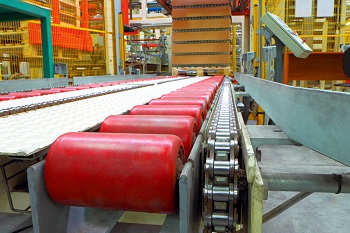When To Replace Your Conveyor System
 United States manufacturers are the most productive in the world. They’re the reason the U.S. surpasses all other manufacturing economies, according to the National Association of Manufacturers. Automation, innovation and old-fashioned business savvy keeps U.S. companies competitive.
United States manufacturers are the most productive in the world. They’re the reason the U.S. surpasses all other manufacturing economies, according to the National Association of Manufacturers. Automation, innovation and old-fashioned business savvy keeps U.S. companies competitive.
Key to staying on top are up-to-date plants. If old equipment is slowing productivity, it might be time to replace your conveyor system.
Learn more about how conveyor systems help business.
Conveyors and other material-handling equipment require a comprehensive system maintenance plan. All those moving parts wear out over time. Bearings, belts, magnets and motors need regular inspection and occasional repair and replacement.
When To Replace Your Conveyor System
How can you tell if your belt needs to be replaced? Take a look at these key characteristics:
Quality Materials: Are the materials in your system failing? Belts are made in different materials and grades. To be durable, the system must to be designed to stand up to your manufacturing processes.
Meets Pre-Tension Requirements: A belt needs the proper tension to avoid slippage and stretching. Faulty tension can cause breakdowns and other problems.
Even Thickness: Uniform belt thickness is a sign of high-quality materials and manufacturing. A belt with thick and thin areas is weak and will break.
Learn more about how to check the quality of your conveyor system.
Even if your conveyor seems like it will last forever, you may need to replace it with a more efficient version. Here’s how to weigh the return on investment of a new conveyor system.
Evaluate Cost
Every company has a threshold for repair costs as they relate to replacement costs. Some companies will invest in a new conveyor when the cost to repair an old one reaches 60 percent of replacement. Others may have a higher threshold depending. Your decision could be based on whether the cost of replacement can be taken out of a repair budget or a capital equipment budget.
Estimate Downtime
Repair versus replacement considerations are influenced by lead times. If repairs will take longer to complete than would delivery and installation of a new conveyor, replacement may be a better option.
Gauge Expansion Potential
A manufacturer’s equipment must support expansion and innovation. As your business grows and your products change, a conveyor that can’t do the same will hinder productivity. If your system is obsolete or your manufacturing processes have outgrown it, replacing it is a worthwhile investment.
While conveyor systems are necessary to automated manufacturing solutions, they are also a critical element in the facility’s efficiency and profitability. That’s why it is important to choose a system customized for your needs and designed to support expansion. Consider each system’s modularity, flexibility, and scalability in addition to factors such as safety and energy efficiency.
Choose The Right Conveyor Belt
Conveyor belt systems are a proven solution for materials handling. The goal of all conveyors is the same: to easily move things from one point to another. But the design of your system depends on your business. We can design systems for light or heavy duty, for food plants or automobile manufacturers, for basic material handling or complex robotic setups.
Conveyor belts are made from a variety of materials, each best suited for a different application. For example, food plants require conveyors that can be sanitized daily. You may need a belt with an abrasion resistant surface. In manufacturing plants, choose a system that resist flames and high temperatures.
A few of your options are belts covered with PVC, nylon, polyester and polyurethane. Some materials may be easier to maintain or longer lasting. Storee’s conveyor installation experts work with you to build a system that meets your goals and budget.
A warehouse operation may require a fairly streamlined system, one that’s reliable but that doesn’t integrate with robotics. For an assembly line, you will require a complex setup that pairs with robots, computers and more. At Storee, our team of designers and engineers has the experience to handle all types of conveyor systems.
Installing a new conveyor is often part of a larger project involving facility modifications and upgrades. If that’s the case, it is important to partner with an experienced industrial contractor who understands your processes. Storee Construction’s team of plant optimization specialists can help you streamline operations, improve productivity and eliminate waste.
Contact Storee to find out more about conveyor installation and plant optimization today. Call 888-736-2032 or email us at info@storee.com.
Updated Feb. 23, 2017. Originally published May 4, 2015.

